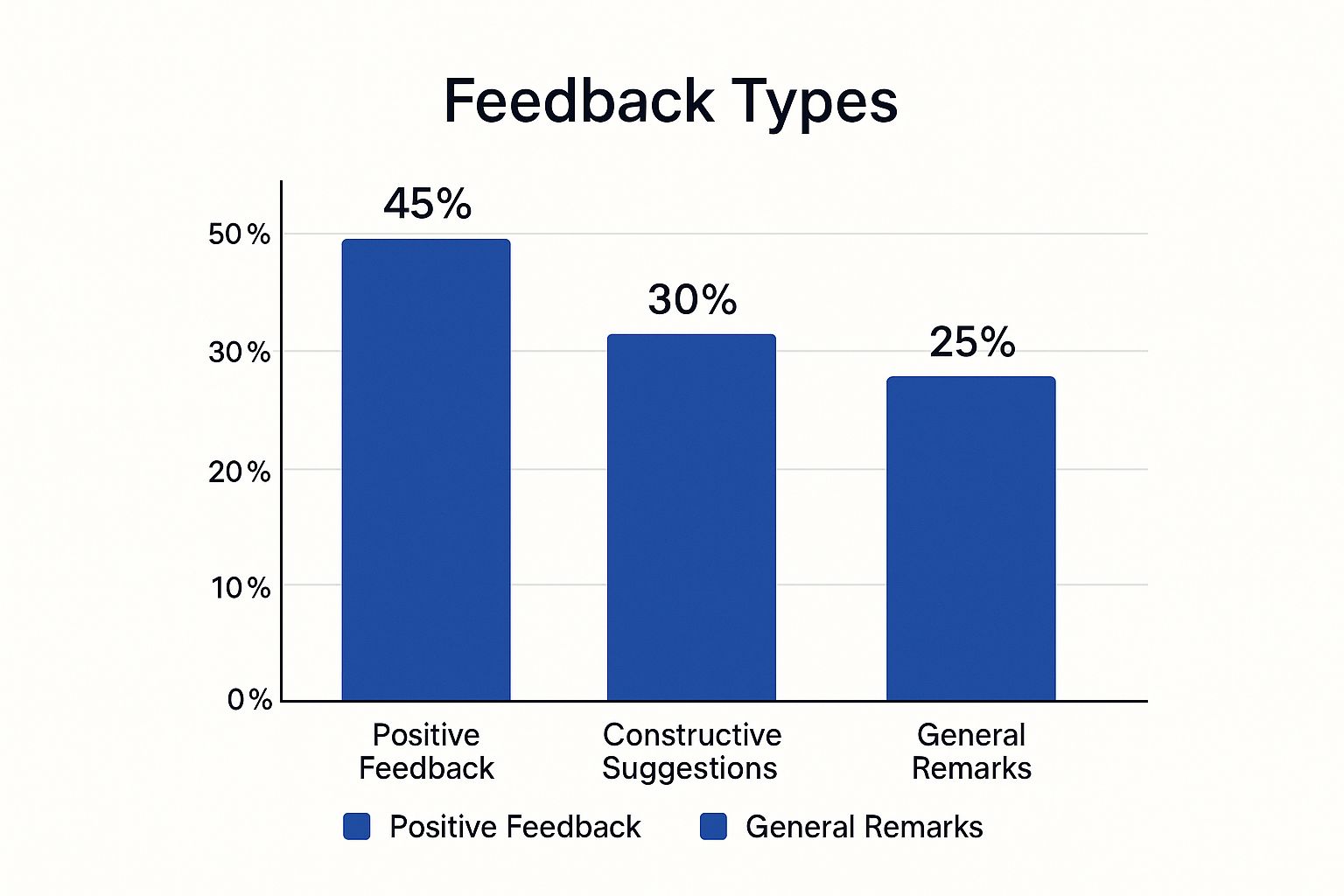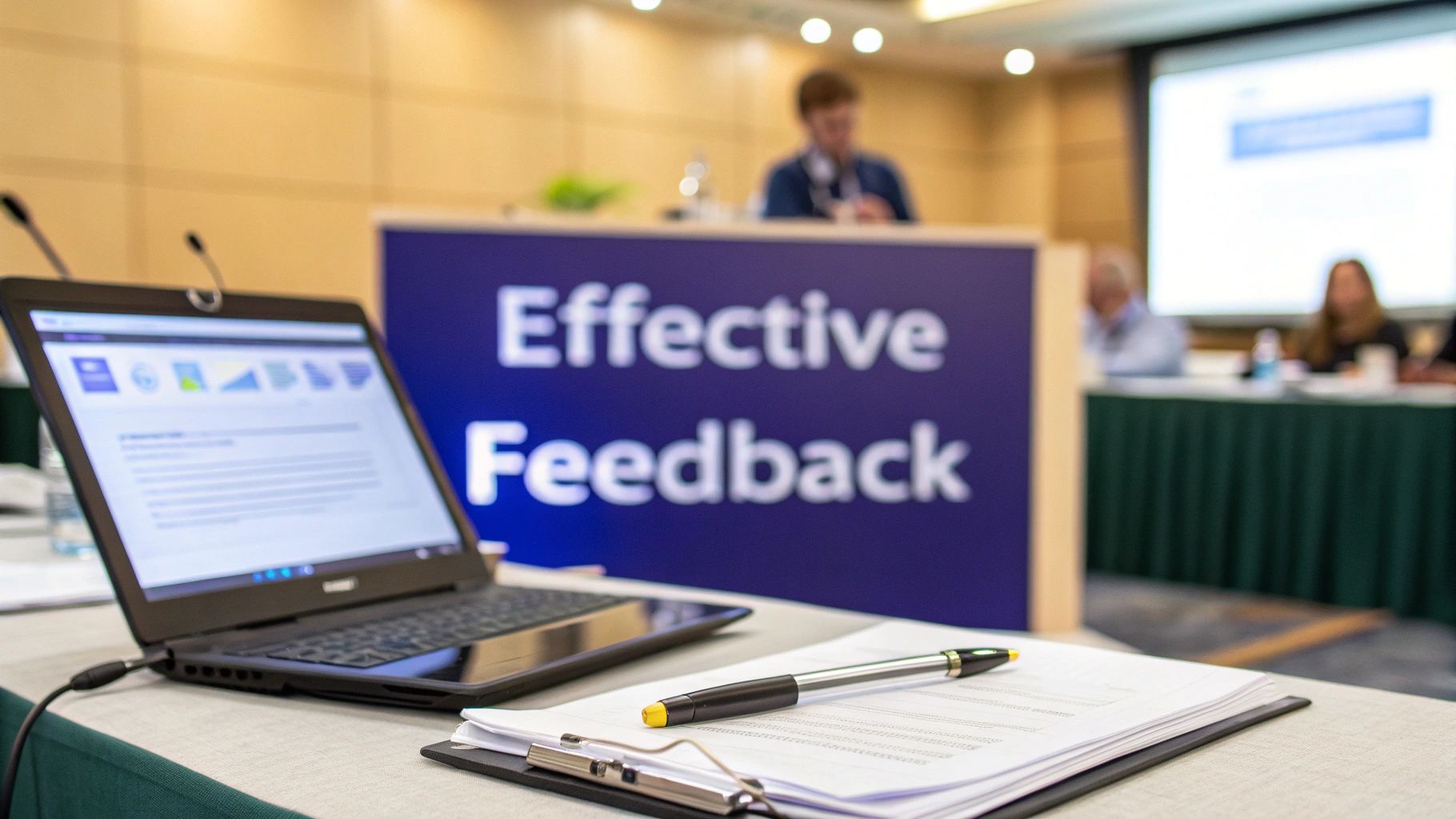Let’s be honest—most of the feedback we give on presentations just doesn’t land. You mean well, of course. But your comments either create more confusion or, worse, put the presenter on the defensive.
We've all been there. Dropping a "great job!" feels good but helps no one improve. Pointing out "you seemed nervous" is just an observation, not a solution. This is exactly why so much feedback falls flat: it’s missing specific, actionable substance.
The real goal isn't just to critique; it's to coach. That requires a mental shift. Stop pointing out what you think are flaws and start identifying opportunities for genuine growth. Instead of focusing on your own impression, think about what the presenter was trying to accomplish. Were they aiming to persuade, to inform, or to inspire? Frame your feedback around that goal, and it instantly becomes a hundred times more powerful.
The Disconnect Between Intent and Impact
There’s a massive gap between the kind of feedback people want and what they usually get. A staggering 72% of employees say that getting critical feedback is crucial for their career development. And yet, a Gallup poll revealed that only 26% of employees feel the feedback they get actually helps them do better work. As research from Harvard Business School highlights, there's a clear paradox: we're hungry for advice that helps us grow, but we rarely receive it.
This is where things usually break down. The feedback we give often leans heavily on general praise or vague criticisms, while the truly helpful stuff gets left out.

The data shows that while positive comments are common, the truly constructive suggestions—the kind that actually spark improvement—are in short supply. To make your input count, you have to learn how to turn those gut feelings into specific, helpful guidance.
The key to unlocking better feedback is moving from vague impressions to concrete, actionable advice. To see what this looks like in practice, here’s a quick comparison.
From Vague to Valuable Feedback
| Vague (Ineffective) Feedback | Valuable (Actionable) Feedback |
|---|---|
| "Your slides were a bit confusing." | "On slide 5, the graph's labels were too small to read from the back. Could you increase the font size or use a simpler chart?" |
| "You need to be more engaging." | "I noticed the audience's energy dipped during the technical demo. What if you started that section with a question to pull them in?" |
| "Great job! Very professional." | "The story you shared about your first client was really powerful. It made the problem you're solving feel personal and urgent." |
| "You seemed nervous at the start." | "You were speaking quite quickly in the first two minutes. Try taking a deliberate pause and a deep breath after your opening line." |
Notice the difference? The valuable feedback gives the presenter something tangible they can work on for their next presentation.
The most valuable feedback answers two simple questions for the presenter: "What should I keep doing?" and "What is one specific thing I could try differently next time?" This simple filter separates generic comments from genuinely useful coaching.
A Practical Framework for Giving Feedback

Alright, let's get down to brass tacks. Theory is great, but you need an actual game plan for delivering feedback that lands well. This isn’t about following a rigid script, but rather having a flexible model that keeps your comments clear, balanced, and easy to act on. The goal is to build confidence, not create confusion.
You’ve probably heard of the classic “feedback sandwich”—that old trick of squeezing a piece of criticism between two compliments. While it sounds nice on paper, it often falls flat in the real world. Most people can spot it from a mile away, making the praise feel forced and insincere. The result? Your main point gets lost, and the whole conversation feels fake.
A Better Way to Structure Your Feedback
Instead of relying on that stale sandwich, let’s try a more genuine approach. This method is all about having a real, constructive conversation that leaves the presenter feeling supported, not attacked. It’s less about a formal critique and more about a collaborative coaching moment. For a broader look at this, you can check out some general tips for providing more effective feedback.
This framework follows a simple, three-part flow:
- Start with something genuinely good. Pinpoint a specific moment or element that really worked. Don't just say "Good job." Get specific. This shows you were actually paying attention and helps build immediate rapport.
- Offer one key area for improvement. Don't overwhelm them with a laundry list of fixes. Focus on the single most impactful thing they could change. Frame it as a forward-looking suggestion, not a criticism of what they did wrong.
- End with a dose of encouragement. Wrap up on a high note. Reiterate your confidence in them and their ability to nail it next time.
For example: "Your opening story was a fantastic hook that immediately grabbed my attention. To make your data section just as compelling, consider adding a visual for the Q2 numbers. You finished with real power, leaving a great final impression."
This simple structure is one of many workplace strategies that can completely change how your team communicates. To learn more, check out our guide on the best practices for feedback and see how small shifts can lead to huge wins.
Giving Feedback on Content and Storytelling

Sure, delivery and visuals matter. But let's be honest—they're just the window dressing. The real heart of any great presentation is its content and the story it tells. If the core message gets lost or the narrative fails to connect, even the most dazzling slides and confident speaker will fall flat.
To give truly valuable feedback, you have to get to the substance of the talk.
Forget generic comments like "that part was unclear." Instead, zero in on the narrative flow. One of the best ways I've found to do this is by using guiding questions. It's a less confrontational, more collaborative approach that encourages the presenter to think critically about their own structure and uncover the gaps themselves.
Ask something simple, like: "If the audience could only remember one single thing from your talk, what would it be?" This question forces the presenter to distill their message down to its absolute core, which often shines a light on where the presentation is losing focus.
Evaluating the Narrative Arc
Every good presentation is a story. It should take the audience on a logical journey from point A to point B. When you're giving feedback, think about that journey. Does each slide or talking point build on the last one? Or are there jarring transitions that leave people confused and trying to catch up?
Here are a few questions I always ask myself when evaluating a presentation's story:
- Is the main idea obvious from the start? Or is the audience left guessing what the point is?
- Can you trace a clear, logical path from the introduction all the way to the conclusion?
- Does the evidence—data, stories, examples—actually support the main points?
For instance, you could say, "I was right there with you until we hit slide 7. Can you walk me through how that data point connects to the final recommendation you make on slide 8?" This is so much more helpful because it pinpoints a specific break in the narrative.
This focus on structure and purpose is a lot like giving good design feedback, where every single element needs to serve a clear function. If you want to dive deeper, we cover this in our complete guide on how to give design feedback.
And if you're looking to broaden your understanding of what makes content effective in general, exploring resources on content performance metrics can give you a great conceptual framework to work from.
Navigating Feedback on Delivery and Body Language
Giving feedback on someone's physical presence and delivery can feel… awkward. It’s personal. But it's also one of the most critical parts of presentation coaching. How a person stands, speaks, and gestures has a massive impact on how their message lands with an audience. Your job is to offer objective, constructive observations, not personal critiques.
The first rule is to banish vague notes like, "You looked nervous." That's not helpful. Instead, focus on the specific, observable actions and what they mean for the audience. This reframes the feedback from a judgment on their internal feelings to a practical coaching tip on their external performance.
Instead of, "You seemed nervous," try this: "I noticed your speaking pace really picked up during the Q&A. If you take a deliberate pause before answering, it could give your responses even more authority." See the difference? It's actionable, not personal.
Connecting Actions to Audience Engagement
The most powerful delivery feedback always ties a speaker's actions back to audience engagement. When you can connect their body language to how the audience might be feeling or reacting, the advice clicks. It becomes a strategic tool, not just a style note.
Here are a few key areas I always watch for:
- Vocal Variety: Is their tone flat, or does it have some life to it? A monotone delivery can make even the most fascinating content feel like a slog.
- Pacing and Pauses: Rushing through slides often screams "lack of confidence" and leaves the audience scrambling to keep up. On the other hand, a well-placed pause can build suspense or give people a moment to absorb a really important idea.
- Eye Contact and Gestures: Are they actually looking at the people in the room, or are they glued to their notes? Meaningful hand gestures can drive a point home, but fidgeting just distracts from the message.
For recorded presentations, this is where modern annotation tools are an absolute game-changer. Trying to describe a fleeting gesture or a shift in tone with words alone is tough.
This is where a tool like BugSmash comes in. It lets you drop comments directly onto a video's timeline, providing pinpoint-accurate feedback.
You can literally drop a pin at the exact moment you're talking about. This completely removes the guesswork. A vague note like "you were fidgeting here" becomes a crystal-clear, actionable insight when the presenter can see the exact moment you're referencing. They can immediately see what you mean and start working on it.
Fostering a Culture of Helpful Feedback

Let's be honest: effective feedback isn't just a one-off conversation. It's the very bedrock of a high-performing, resilient team. When we move beyond the dreaded annual review, we start building an environment where continuous improvement is just how things are done.
Infrequent, formal reviews often miss the mark. They tend to bottle up observations, turning feedback into a high-stakes, anxiety-riddled event instead of what it should be: a routine part of collaboration.
The real goal here is to cultivate psychological safety. It's a space where peer-to-peer comments are not just welcomed but actively sought out. When people feel safe, they're more willing to be vulnerable, share unfinished work, and ask for the input they need to get better. This shifts the entire dynamic from a dreaded critique into a shared tool for collective success.
Make Feedback a Daily Habit
Waiting for a formal review cycle to share insights is a massive missed opportunity. The most powerful feedback is almost always the most immediate. In fact, research shows that 80% of employees who received meaningful feedback in the past week report being fully engaged at work.
It turns out that frequent, in-the-moment coaching is what people actually want and need to perform their best.
Weaving this into your team’s daily rhythm is easier than you think:
- Post-Meeting Check-ins: Carve out the last two minutes of a team meeting for quick, focused presentation feedback.
- Peer-to-Peer Previews: Encourage team members to do a dry run of their presentation with a colleague before the big day.
- Celebrate the Process: Publicly acknowledge when someone gives or receives feedback well. This reinforces its value more than any memo ever could.
To truly build this culture, you have to empower your team with the right mindset and tools. It's about teaching them how to give feedback that drives results, not just telling them to do it.
This shift takes more than just good intentions. It demands clear, practical strategies for how to give constructive feedback and drive results. A big part of this involves creating channels for honest and unbiased feedback, especially when the topics are sensitive.
By making feedback a consistent, low-stakes practice, you turn it from a source of fear into your team’s greatest asset for growth.
Answering the Tough Questions About Presentation Feedback
Giving good feedback is a skill, and even with the best intentions, you’re going to hit some tricky situations. Let's walk through a few common curveballs and how to handle them like a pro.
What if the Presenter Gets Defensive?
It’s bound to happen. You offer a suggestion, and suddenly, the walls go up.
When someone gets defensive, your first move should be to pause and just listen. Whatever you do, don't repeat your point or try to "win" the argument. Instead, shift the dynamic from a confrontation to a conversation. Try asking something open-ended, like, "Help me understand your thinking on this part."
Defensiveness often stems from feeling attacked or misunderstood. By showing you’re genuinely curious about their perspective, you can disarm the situation and build a bridge back to a more collaborative discussion.
How Do I Give Feedback to My Boss?
Giving feedback up the ladder can feel like walking on eggshells, but it doesn't have to be. The secret is to frame your comments around shared goals. You're not telling them they're wrong; you're offering a perspective to help the team or project succeed.
For example, instead of saying, "You should put the data slide earlier," try something like: "That data on slide 10 was incredibly compelling. I have a hunch it would hit even harder with the client if we led with it in our next pitch. What do you think?" This approach is helpful, not critical, and positions you as a strategic partner.
These kinds of challenges highlight a bigger issue in many workplaces. A staggering 90% of managers are unhappy with their company's performance review process, largely because it fails to foster genuine growth. In fact, half of all employees say the feedback they get isn't even useful for their career goals—a massive missed opportunity. You can find more stats on why better feedback processes are in high demand on peacefulleadersacademy.com.
What if the Presentation Needs a Lot of Work?
We've all been there. You sit through a presentation, and your mental list of "fixes" is a mile long. Your first instinct might be to unload all of it. Don't. Drowning someone in a sea of criticism is the quickest way to overwhelm them and kill their motivation.
Instead, you need to prioritize. Ask yourself one simple question: "What's the one thing that will make the biggest impact right now?"
Focus your feedback entirely on that single, high-impact point. Give them a clear, actionable place to start. You can always circle back to the smaller stuff later, but for now, give them a winnable battle.
Ready to make your feedback process faster and way more effective? BugSmash lets you leave precise, timestamped comments directly on video, PDF, and image files. It cuts out the confusion and saves you hours of back-and-forth. Try it for free and see how much easier collaborative reviews can be.


![Read more about the article How to Annotate a PDF in 5 Simple Steps [2025 Workflow Guide]](https://bugsmash.io/blog/wp-content/uploads/2025/05/how-to-annotate-pdf-easily-768x768.jpg)

